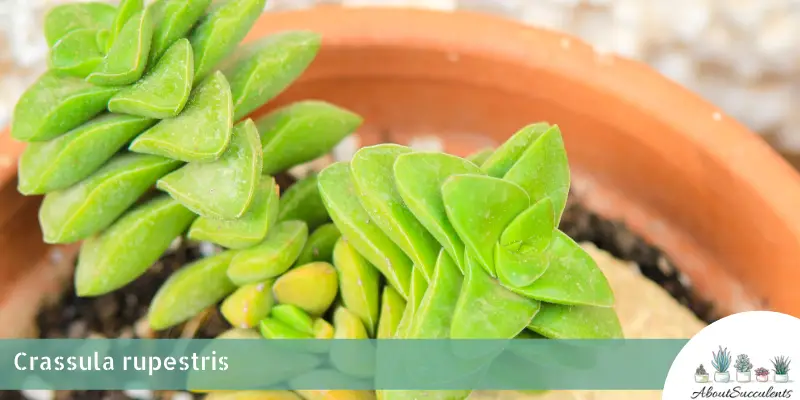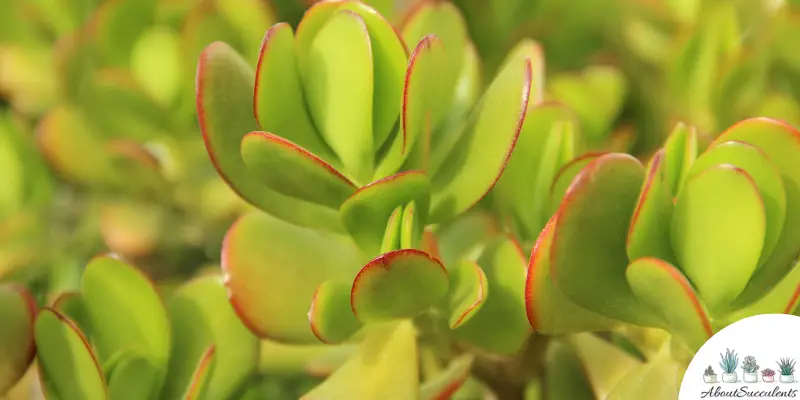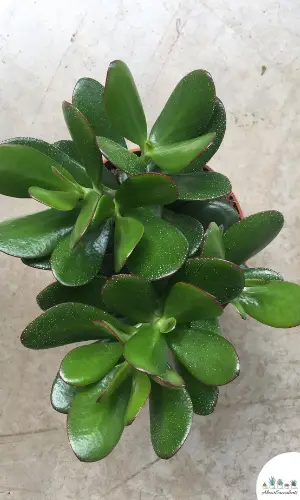
Crassula rupestris is an adorable succulent that grows thin stems with small, thick, oval-shaped leaves. In fact, its botanical name is derived from the Latin word “Crassus” which means fleshy or thick. The second part of its name “rupestris” means rocks.
The leaves of Crassula rupestris start out as having shades of yellow and red in the summer then develop grey accents on their edges the rest of the year.
Crassula rupestris goes by several nicknames. Among the most popular are “Baby’s Necklace Vine”, “Kebab Bush”, “Bead Vine”, “Rosary Plant”, and “Concertina Plant”.
The aliases are quite descriptive because Baby’s Necklace Vine initially grows erect and then spills out as it matures. Fully-grown Crassula rupestris appears like multiple free-flowing shrublets where the leaves that lie opposite of the shoots give the impression of a string of beads.
In the springtime, Rosary Plant produces star-shaped flowers that might have a white or pinkish color with a hint of purple.
Crassula rupestris can reach a height of 3-feet (91.44cm). It comes from the genus Crassula and belongs to the Crassulaceae family of jade plants. Baby’s Necklace Vine is native to South Africa.
General Information
Also known as: Baby’s Necklace Vine, Kebab Bush, Bead Vine, Rosary Plant, and Concertina Plant.
Plant Family: Crassulaceae
Origin: South Africa
Height: 3-feet (91.44cm)
Exposure: Partial or full sun for up to 6 hours per day; avoid the afternoon sun as the leaves can burn
Water Needs: Drought-tolerant; only water the soil when it’s 100% dry. When watering, give the soil a good soaking.
Soil Type: Cactus soil or a succulent soil mix with added gritty materials like coarse sand, pumice, and perlite for better drainage
Soil pH: 6.0
How to Grow and Care for Crassula Rupestris

Crassula rupestris is a succulent plant that can be grown outdoors in terrariums or as part of a miniature garden. Likewise, Baby’s Necklace Vine will be just fine if grown indoors.
If you’re a novice horticulturist, you can test your green thumb with Crassula rupestris. It’s a succulent that’s durable and easy to grow and care for.
One thing you need to keep in mind is that Rosary Plant isn’t cold-hardy. It cannot survive frosty temperatures. If the mercury in your region drops below 30° F (-1.1° C), we recommend growing Crassula in a pot that can be moved indoors.
Sunlight
Crassula rupestris is best grown outdoors because sunlight is more accessible. As a garden succulent, plant Baby’s Necklace Vine in a location that regularly gets 6 hours or partial or full sunlight every day.
If you decide to grow Kebab Bush as a houseplant, make sure it gets the required dose of the sun’s rays. Partial sunlight is fine but you might want to place the succulent under a Grow Light for best results.
Without enough sunlight, Crassula rupestris’ beautiful leaves can etiolate or stretch out. When this happens, the leaves lose their eye-catching shape, thin out, wither, and die.
Watering

The biggest mistake first-time succulent growers make is to treat Crassula rupestris like any ordinary plant and water it as often as possible. Keep in mind that succulents are able to survive drought and long dry spell periods because these plants store water in their leaves and stems.
If you water the plant too often, the soil becomes a breeding ground for bacteria. Also, if the roots are kept in a moist environment for a long time, they will rot and rupture leaving your plant susceptible to fungal infection.
This is why the “Soak and Dry” method is highly recommended when watering Baby’s Necklace Vine. Using this method, you first have to check the soil’s level of dryness by inserting a stick an inch deep.
If the stick feels dry, then it’s perfectly safe to water the soil. That’s another important thing to keep in mind – water the soil and not the plant.
Give the soil a good soaking. If Kebab Bush is grown in a pot, once the water leaks out of the drain hole, you can stop the watering process.
Pot and Soil
When shopping for pot and soil, your priority should be drainage. As we mentioned in the previous section, prolonged exposure to moisture will harm Crassula rupestris.
Choose a pot that’s made of either unglazed ceramic or terracotta because these materials promote soil aeration and enable excess moisture to escape along their sides.
Always make sure that the pot has a drainage hole at the bottom to filter out excess water.
Cactus soil or a commercially available succulent mix are good choices because these types of soil drain very fast. To be sure, add 50% gritty materials such as perlite, coarse sand, pumice, or lava rocks.
How to Propagate Crassula Rupestris
Are you looking to add more Rosary Plant to your outdoor garden? The good news is that you can propagate Crassula rupestris using 2 methods: Stem cuttings and leaves.
Stem Cuttings Method
Step 1: Choose a healthy stem and cut a small section using a sterilized and sharpened knife or garden shears.
Step 2: Place the stem cuttings in a dry area. Give it 2 to 4 days to grow hard calluses.
Step 3: Once the calluses have formed on the stem cuttings, place them on top of the cactus or succulent soil. Make sure the stem cuttings are far apart so that the roots don’t get tangled.
Step 4: Water the soil lightly and place the pot near a window that gets 4 to 6 hours or partial to full sunlight.
Step 5: If the roots have appeared, switch to the “Soak and Dry” method and only water the soil when you’ve tested and confirmed its level of dryness.
Leaves Method
Step 1: Look for a healthy leaf then perform a clean twist and pull. If a part of the leaf remains on the stem, repeat the process. Otherwise, propagation won’t be successful.
Step 2: Let the leaves dry out and develop calluses. This stage might take 2 to 4 days.
Step 3: After the leaves have callused over, place them on top of well-draining soil.
Step 4: Lightly water the soil and move it to an area that receives 6 hours of sunlight every day.
Step 5: Check the leaves from time to time. If you notice that the roots have formed, only water the soil when it is absolutely dry.
Frequently Asked Questions
Is Crassula Rupestris Toxic to Cats and Dogs?
Crassula rupestris doesn’t appear in the list of plants that are toxic to cats and dogs found on the website of the American Society for the Prevention of Cruelty to Animals (ASPCA).
However, keep in mind that this is only a partial list. Crassulas, particularly those that belong to the jade plant family contain sap that can be harmful to pets.
If you notice your pet exhibiting symptoms such as lack of appetite, weakness, and vomiting, bring the animal right away to the Veterinarian.
Why Is My Crassula Rupestris Dying?
Crassula rupestris is a tough plant that can withstand harsh weather conditions but it can get sick and die due to overwatering and pest infestation.
You can get Baby’s Necklace Vine back to being healthy if you act right away when you see signs of infection.
Overwatering
Hands down, the number one cause of death of succulents is overwatering. You’ll know that you gave Kebab Bush more water than it needed if you notice discoloration on the leaves or if the plant looks mushy.
Don’t take chances and grab a pair of garden shears or a knife. Wear gloves to protect yourself from the sap and sterilize the cutting tool with 70% isopropyl alcohol.
Cut off the infected sections to keep the bacteria from spreading to other parts of the plant. Every time you cut, sterilize the cutting tool so that it won’t contaminate other areas.
When this has been completed, shift your attention to the roots where all of the trouble started. Remove the plant from the soil and inspect the roots closely. Cut off the roots that have gone rotten.
Let the plant recover from the trauma. Your next step is to prepare its new home. Yes, get a new pot because even if you wash the old one, there’s no guarantee that there are no bacteria left over.
Fill the new pot with well-draining soil and replant Rosary Plant. Don’t water the soil right away. Give Crassula rupestris 2 to 3 days to get used to the new environment.
Pest Infestation
Do you notice white, waxy, cottonlike substances on the leaves of Crassula rupestris? That means you have squatters inside your beloved succulent. These substances are the byproducts of pests known as mealybugs.
You have to remove these waxy substances right away because they can become infectious. Simply wipe them off with a cotton ball dipped in a mild fungicide or 70% isopropyl alcohol. To protect Crassula rupestris from pest infestation, spray it with diluted neem oil.
Yes, Crassula rupestris produces flowers in the springtime. The flowers are small, star-shaped, and can appear white or pink with a hint of purple.
Last Updated on June 9, 2022 by Sofia Lara